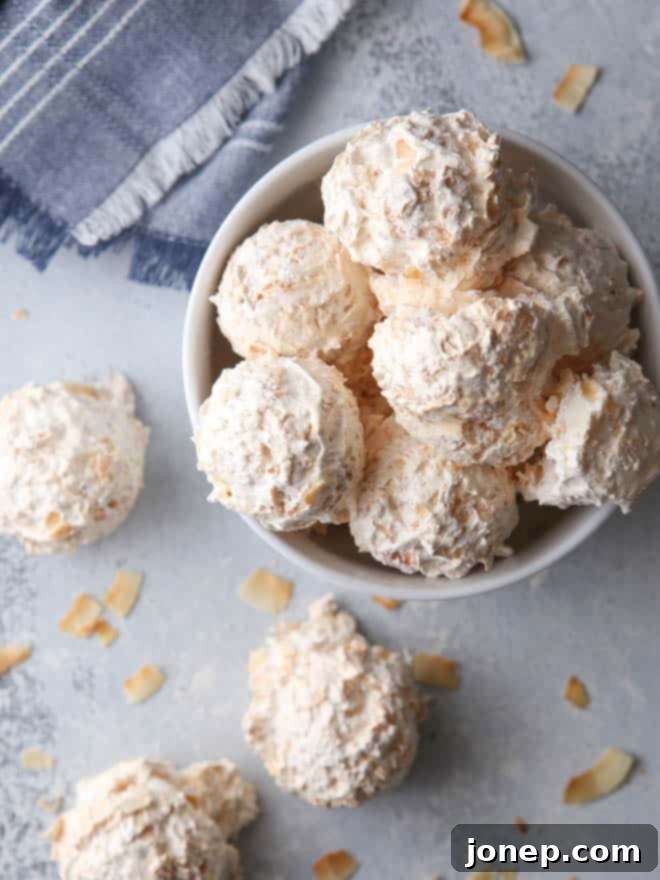Irresistible Coconut Meringue Macaroons: Light, Chewy & Perfectly Sweet
Prepare to fall in love with these incredibly light, airy, and wonderfully chewy coconut meringue macaroons. Crafted with just a few simple ingredients and a stable Italian meringue base, these delightful snowballs offer a taste and texture combination that’s truly irresistible. Forget overly complex baking; this recipe simplifies the process, making gourmet-quality macaroons accessible to every home baker.
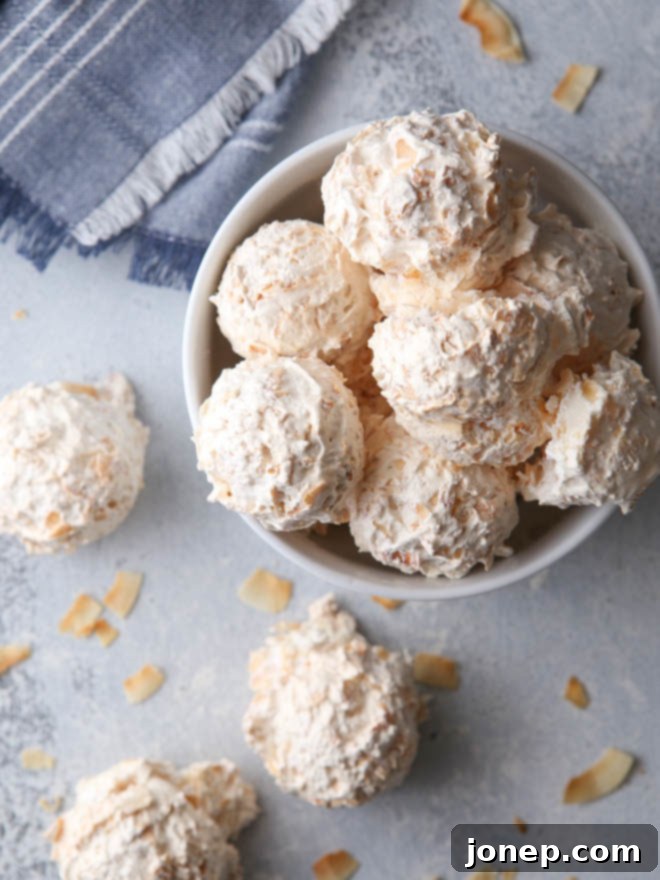
What happens when the delicate, cloud-like texture of a perfectly whipped meringue meets the rich, sweet, and intensely satisfying flavor of a classic coconut macaroon? You get these divine little confections! These aren’t your ordinary cookies; they are a harmonious blend, offering a crispy exterior that yields to a soft, chewy, and melt-in-your-mouth interior, bursting with toasted coconut goodness.
The secret to their exceptional structure and delightful chewiness lies in the Italian meringue. This method involves slowly pouring hot sugar syrup over rapidly whipped egg whites, creating a remarkably stable and glossy meringue that forms the heart of these treats. Once this foundation is perfected, we fold in an generous amount of unsweetened toasted coconut, ensuring every bite is packed with tropical flavor. A quick bake until they turn beautifully golden brown, and you’ll have a batch of treats that look deceptively simple but deliver an extraordinary experience. They offer a delightful contrast of textures and a deeply satisfying sweetness that makes them a favorite for many.
Don’t let their unassuming, plain appearance fool you; these coconut meringue macaroons are a true showstopper. I’ve personally baked countless batches of these over the years for friends, family, and special gatherings, and with each attempt, my appreciation for their elegant simplicity deepens. They strike the perfect balance: light enough to feel guilt-free, sweet enough to satisfy any craving, and wonderfully chewy, making them utterly addictive. They are a timeless dessert that appeals to all palates, perfect for special occasions, holiday cookie platters, or simply elevating an ordinary afternoon with a homemade sweet treat.
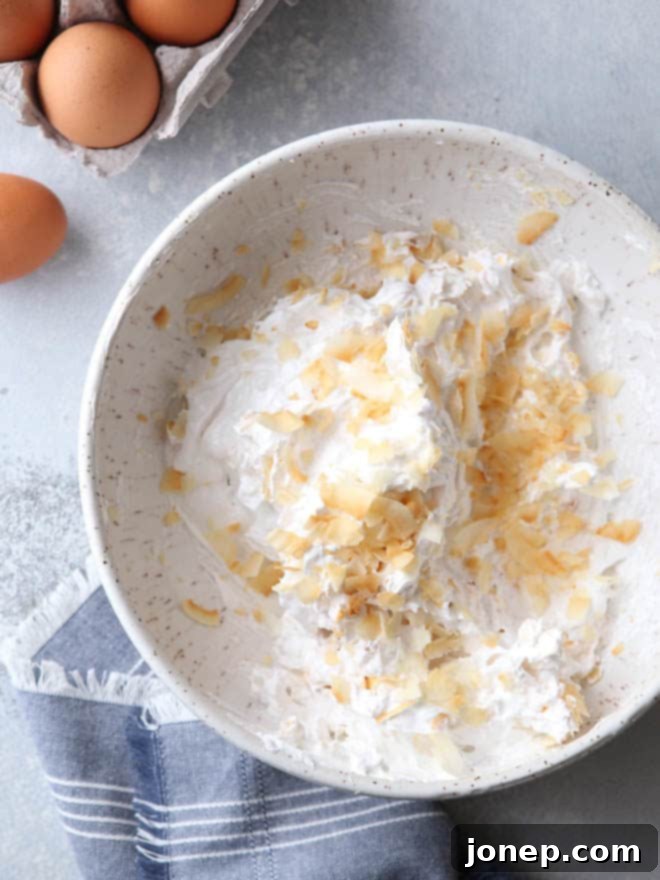
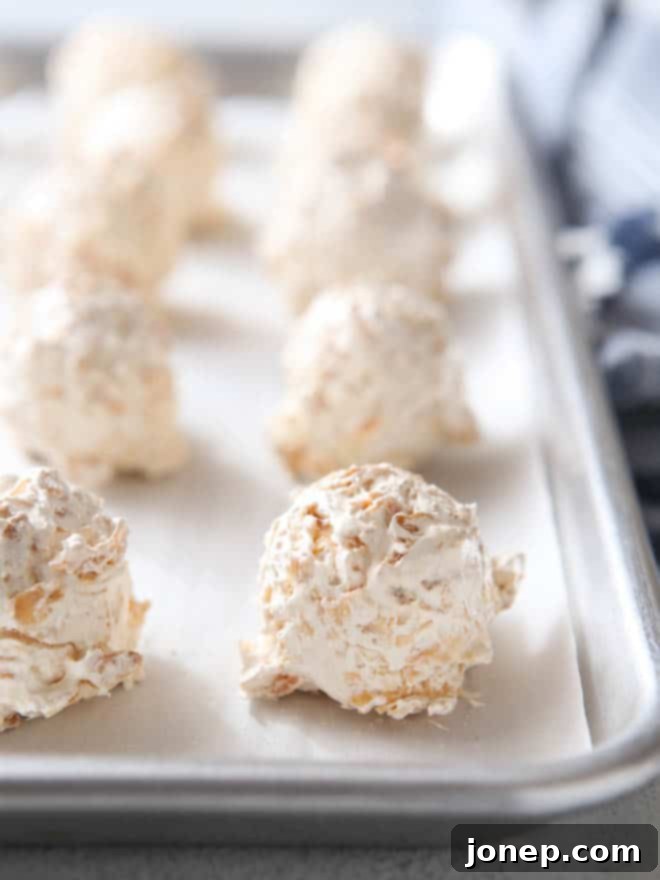
The Art of Italian Meringue: Precision and Patience for Perfect Macaroons
At the heart of these exquisite coconut macaroons is a perfectly executed Italian meringue. This meringue is renowned for its exceptional stability, beautiful glossy texture, and the added safety of cooked egg whites. However, achieving this perfection hinges on precise timing and temperature control, making it the most critical step in the recipe. Mastering Italian meringue is a valuable skill that will elevate many of your baking endeavors, from soufflés and lemon tarts to elegant buttercream frostings.
Why Timing is Everything for Italian Meringue
When preparing Italian meringue, two distinct elements must align perfectly: the sugar syrup reaching its precise temperature and the egg whites whipping to the correct consistency. The sugar syrup needs to be cooked exactly to 238 degrees F (114 degrees C), a stage commonly referred to as the “soft ball stage.” Most reliable candy thermometers will clearly mark this stage. At this temperature, the sugar syrup, when dropped into cold water, forms a soft, pliable ball that can be gently pressed. If the sugar is undercooked, your meringue will be too soft and won’t hold its shape or incorporate enough air, resulting in flat, sticky macaroons. If it’s overcooked, it will become brittle and difficult to incorporate smoothly, potentially creating grainy meringue or sugar crystals in your final product.
Simultaneously, your egg whites must be whipped to medium peaks. This means they should hold their shape when the whisk is lifted, but the tip should curl slightly downwards. If the egg whites are under-whipped, they won’t be able to incorporate the hot sugar syrup properly, leading to a runny, unstable meringue. If they are over-whipped to stiff peaks too early, they can become dry and crumbly, making it hard to achieve that signature glossy, smooth finish and potentially collapsing once the hot syrup is added.
Achieving Perfect Synchronization
The key challenge is having both the sugar syrup and egg whites ready at the same time. I’ve developed a rhythm over many attempts that helps ensure success, and with a little practice, you’ll find your own:
- Start the Sugar Syrup First: Begin cooking your sugar syrup over medium heat. It generally takes longer to reach the target temperature than it does to whip egg whites to medium peaks.
- Monitor the Thermometer Closely: Keep a keen eye on your candy thermometer. When the sugar mixture reaches approximately 220 degrees F (104 degrees C), it’s the ideal moment to start whipping your egg whites on medium-high speed.
- Adjust Heat and Speed as Needed: This is where practice truly comes in handy. If your sugar syrup is rising too quickly, you can slightly reduce the heat under the saucepan. Conversely, if your egg whites are taking too long to reach medium peaks, you can increase the mixer speed. The goal is to have the egg whites at medium peaks just as the sugar syrup hits 238 degrees F (114 degrees C). Don’t be afraid to make minor adjustments to synchronize these two crucial components. Even a few degrees or a minute or two can make a significant difference in the final texture of your meringue.
- Pour in a Slow, Steady Stream: Once the syrup is ready, immediately and carefully pour it in a slow, thin, steady stream into the whipping egg whites. Make sure to aim for the side of the bowl, allowing the syrup to fall into the meringue mixture, avoiding the whisk itself. This prevents the hot sugar from splattering and caramelizing on the whisk or the bowl sides. This gradual addition gently cooks the egg whites, creating an incredibly stable and safe meringue.
- Cool Down to Perfection: Continue beating the meringue on high speed after all the syrup has been incorporated. This step is vital as it not only incorporates maximum air but also cools and stabilizes the meringue, resulting in a thick, glossy, and marshmallow-like consistency that is perfect for folding in the coconut. Beat until the bowl is cool to the touch from the outside, indicating the meringue has reached room temperature.
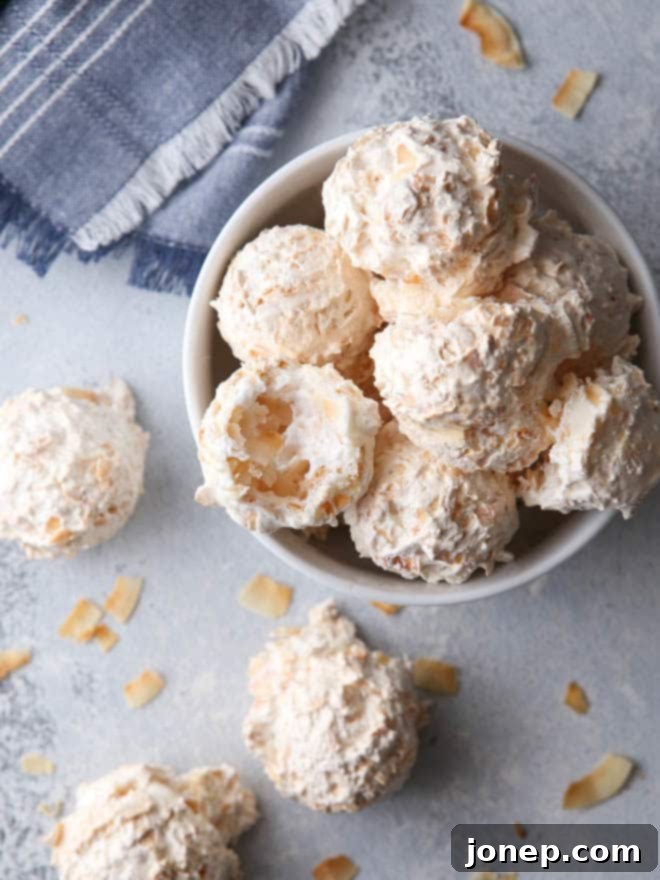
Essential Ingredients for Flawless Coconut Meringue Macaroons
While the list of ingredients for these macaroons is delightfully short, understanding the role of each component ensures a perfect batch every time. Quality ingredients are the foundation of any great dessert.
- Granulated Sugar & Water: These two form the base of our hot sugar syrup. Granulated sugar provides the necessary sweetness and structure to the meringue, while water helps dissolve it uniformly and allows the syrup to reach the correct temperature without burning or crystallizing. Using a good quality, fine granulated sugar is recommended for the smoothest syrup.
- Large Egg Whites (at room temperature): Room temperature egg whites are crucial as they whip up faster and achieve significantly greater volume and stability than cold ones. This increased volume translates directly to a lighter, airier meringue and ultimately, a more tender macaroon. When separating eggs, ensure there is absolutely no trace of yolk, as even a tiny speck of fat can prevent egg whites from whipping properly, leading to a runny meringue.
- Unsweetened Coconut: This is where the magic of intense coconut flavor truly shines! Using unsweetened coconut allows you to precisely control the overall sweetness of the macaroon, letting the natural sweetness of the Italian meringue come through without being cloyingly sweet. You can use either finely shredded or wider flaked coconut, depending on your preferred textural experience. Toasting the coconut beforehand is a non-negotiable step for intensifying its flavor and adding a beautiful golden hue. This simple, often overlooked step, elevates the macaroons from good to extraordinary, bringing out nutty, caramelized notes that are essential for deep coconut flavor.
Expert Tips for Coconut Meringue Macaroon Perfection
Even with a seemingly simple recipe, a few expert tips can make all the difference in achieving bakery-quality coconut meringue macaroons that are consistently delicious:
- Clean Equipment is Absolutely Key: Before you begin, ensure your mixing bowl and whisk attachment are impeccably clean and completely free of any grease or oil residue. Even a tiny speck of fat can prevent egg whites from whipping up properly, leading to a flat, failed meringue. Wipe everything down with a paper towel and a little white vinegar if you’re unsure.
- Don’t Skip Toasting the Coconut: As emphasized, toasting the coconut drastically improves its flavor profile, adding depth and complexity. Spread it in a single layer on a baking sheet and watch it like a hawk in the oven; coconut can go from perfectly golden to burnt in a matter of seconds. Stirring it once or twice during toasting helps ensure even browning. Allow it to cool completely before folding into the meringue.
- Invest in a Reliable Candy Thermometer: For Italian meringue, precision in temperature is paramount. A good quality, accurate candy thermometer is your most valuable tool here. It takes all the guesswork out of achieving the soft ball stage (238°F / 114°C) and is essential for consistent, successful results.
- Fold Gently and Delicately: Once your Italian meringue is thick, glossy, and cooled to room temperature, gently fold in the toasted coconut using a rubber spatula. Use a cutting and folding motion. Overmixing can deflate the meringue, resulting in dense, heavy macaroons instead of light, chewy ones. The goal is to combine just until uniform, preserving as much air as possible.
- Consistent Scooping for Even Baking: Use a cookie scoop (a small one for miniature macaroons or a large one for more substantial treats) to portion the mixture onto your prepared baking sheet. This not only makes them look professionally uniform but also ensures they bake evenly, preventing some from being undercooked while others are overdone.
- Cool Completely for Optimal Texture: After baking, allow the macaroons to cool completely on the baking sheet. They will firm up as they cool, developing their signature chewy interior and slightly crispy exterior. Rushing this step can result in soft, crumbly macaroons.
- Proper Storage is Important: Store cooled macaroons in an airtight container at room temperature. They tend to taste even better the day after baking as the flavors meld and the texture settles. They will keep well for up to a week.
Serving Suggestions and Delicious Variations
These coconut meringue macaroons are absolutely delightful on their own, offering a perfect balance of sweet and chewy. However, they also offer a fantastic canvas for creative additions and serving ideas:
- Chocolate Dip: For a truly decadent treat, dip the cooled macaroons in melted dark, milk, or even white chocolate. A delicate drizzle of melted chocolate over the tops also adds an elegant touch and extra flavor.
- Citrus Zest: Add a teaspoon of finely grated orange or lime zest to the coconut mixture before folding it into the meringue for a bright, refreshing, and aromatic twist that complements the coconut beautifully.
- Flavor Extracts: A splash of pure vanilla extract (added to the egg whites before whipping) or almond extract can subtly enhance the flavor profile, adding another layer of complexity to the sweetness.
- Serving Ideas: Pair them with a hot cup of coffee or a fragrant tea for a sophisticated afternoon snack. They also make a beautiful and impressive addition to a dessert platter for parties, holiday gatherings, or potlucks. Their light appearance makes them perfect for spring and summer events.
Macaroons vs. Macarons: What’s the Delicious Difference?
It’s a common point of confusion, but “macaroons” and “macarons” are indeed two distinct, albeit delicious, desserts! Our recipe features macaroons—these are typically dense, delightfully chewy, coconut-based cookies, often mounded and sometimes dipped in chocolate for an extra treat. They are rustic, comforting, and packed with shredded coconut, offering a rich texture. Macarons, on the other hand, are delicate French sandwich cookies made from almond flour, egg whites, and sugar, characterized by their smooth, perfectly round dome-shaped tops, delicate “feet” (the ruffled edge), and a creamy filling. While both are delicious meringue-based treats and share a similar linguistic origin, their ingredients, textures, and appearances are quite different. This recipe proudly celebrates the delightful, chewy, and intensely coconutty goodness of the classic coconut macaroon.
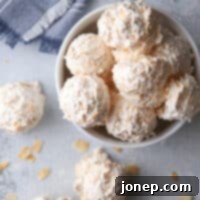
Coconut Meringue Macaroons
Pin Recipe
Leave a Review
Ingredients
- 1 ¼ cup granulated sugar (250 grams)
- ¾ cup water (178 ml, 6 fl oz)
- 3 large egg whites , at room temperature
- 3 cups unsweetened coconut (8 oz, 227 grams)
Instructions
-
Preheat oven to 325 degrees F (160 degrees C). Line a large sheet pan with parchment paper, which will prevent sticking and make cleanup easier.
-
Spread the unsweetened coconut evenly onto a separate, clean large sheet pan. Toast in the preheated oven for about 3-5 minutes, stirring once or twice to ensure even browning, until it’s lightly golden brown and wonderfully fragrant. This step significantly boosts the coconut flavor. Watch carefully to prevent burning, as coconut can brown quickly. Remove from oven and set aside to cool completely.
-
In a small, heavy-bottomed saucepan, combine the granulated sugar and water. Place over medium heat and stir constantly until the sugar is completely dissolved. Once dissolved, stop stirring and bring the mixture to a rolling boil. Carefully insert a candy thermometer into the syrup, ensuring the tip doesn’t touch the bottom of the pan to get an accurate reading.
-
While the sugar mixture is cooking, place the room temperature egg whites in the impeccably clean bowl of a stand mixer fitted with a whisk attachment. When the sugar mixture reaches approximately 220 degrees F (104 degrees C), begin to whip the egg whites on medium-high speed. The critical goal here is to have the egg whites whipped to medium peaks (they should hold their shape but with a soft curl at the tip) at the exact moment the sugar mixture reaches 238 degrees F (114 degrees C – the soft ball stage). Adjust your mixer speed or heat under the sugar if necessary to synchronize these two elements perfectly.
-
As soon as the sugar mixture reaches 238 degrees F (114 degrees C), immediately decrease the mixer speed to medium-low. Carefully and slowly pour the hot sugar syrup into the whipping egg whites in a thin, steady stream. Aim the stream at the side of the bowl, allowing it to incorporate into the meringue, and avoid hitting the whisk directly to prevent splatters. Once all the sugar syrup is incorporated, increase the mixer speed to high and continue beating until the meringue is very thick, glossy, and the bowl is cool to the touch from the outside. This indicates it has reached room temperature and is stable.
-
Gently fold in the cooled toasted unsweetened coconut by hand using a rubber spatula, until just combined. Be careful not to overmix, which can deflate the meringue. Use a cookie scoop (a small scoop for smaller macaroons or a large one for more substantial treats) to portion the mixture onto the prepared parchment-lined sheet pan, leaving a little space between each. Bake until the macaroons just begin to turn golden brown around the edges and on top, about 12-17 minutes, depending on their size. Let cool completely on the sheet pan before transferring, as they will firm up and become perfectly chewy as they cool. Store in an airtight container at room temperature for up to 1 week.
Notes
- You can use either wide slice or finely shredded unsweetened coconut for this recipe. Both will yield delicious results once properly toasted, so choose based on your preferred textural experience.
- For consistent sizing and even baking, using a cookie scoop is highly recommended. Opt for a small cookie scoop for miniature macaroons or a large cookie scoop for more substantial, bakery-style treats.
- Ensure all your equipment (especially the mixer bowl and whisk) is spotless and completely grease-free. Any fat can prevent egg whites from whipping into a stable meringue.
- An accurate and reliable candy thermometer is absolutely crucial for achieving the perfect soft-ball stage (238°F / 114°C) with the sugar syrup, which is fundamental to a successful Italian meringue.
